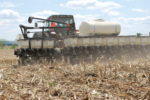Advertise Follow Us
Items Tagged with 'twin rows'
ARTICLES
Despite his location, Doug Rogers has tackled no-till, twin rows, cover crops, controlled traffic and efficient fertility practices in an effort to leave his Ontario farm in better shape.
Read More
Twin Rows, Covers and Chicken Litter Complete an Evolving No-Till System
The Kutzes have continually tweaked their equipment and practices to achieve a level of production they didn’t think was possible.
Read More
Building A Farm From The Ground Up
For Jim Kline, tiling, onfarm research and reduced tillage are a foundation for success, but ‘farming with integrity’ is the heart of his family’s operation.
Read More
Cutting-Edge Planting And Seeding Equipment
Options, flexibility and precision are hallmarks of the new planters and drills unveiled at the 2009 Farm Progress and Big Iron shows
Read More
Are Twin Rows The Corn System Of The Future?
The push is on to increase corn yields to a 300-bushel U.S. average. Twin rows may allow corn roots room to grow to capture nutrients and water, while allowing plants to capture more available sunlight.
Read More
After 32 Years Of No-Tilling, Truths Emerge From His Fields
Paul Schaffert has faced his no-till challenges through the decades, and he’s learned from both the ups and the downs. He offers his advice here.
Read More
What I've Learned from No-Tilling
After Three Decades Of No-Tilling, There's Still More To Learn
Never stop looking to improve your fields, your cropsand your profits, says one of the early adopters of no-tilling.
Read More











